On 7/26/2023, we listed the Global X Dow 30 Covered Call & Growth ETF (DYLG) on the New York Stock Exchange. DYLG is the latest addition to Global X’s covered call ETF suite, which is designed to offer investors both income and upside potential (though some may cap that potential). DYLG is our newest addition to the Global X covered call & growth lineup, which includes the Global X Nasdaq 100 Covered Call & Growth ETF (QYLG), the Global X S&P 500 Covered Call & Growth ETF (XYLG), and the Global X Russell 2000 Covered Call & Growth ETF (RYLG) in addition to our sector-based covered call and growth solutions. These covered call and growth funds write covered calls on 50% of the value of the underlying indexes or sector funds.
Recent market performance within the United States has been driven in large part by interest rate decisions from the Federal Reserve (Fed), economic data surrounding inflation, and the ebbs and flows of the labor market. These forces have prompted elevated levels of volatility for equities and fixed income instruments alike. The rate environment has lent support to income-driven accounts, which have long been mired by an unfavorable backdrop. However, with the Fed’s path to tame inflation potentially reaching a plateau, and the jobs market proving fairly resilient, investors may well want to start leaning into potential changes in implied volatility by gaining exposure to options and the underlying market concurrently.
DYLG: A Covered Call ETF Designed for Income and Growth Potential
- The Global X Dow 30 Covered Call & Growth ETF (DYLG) buys the securities in the Dow Jones Industrial Average at the respective weights of that index, providing a differentiated exposure relative to other major domestic indices.
- By writing at-the-money (ATM) index call options on 50% of the value of the stocks owned in the fund, investors are able earn premium income and benefit from roughly half of the upside potential of the underlying index.
- Specific trading environments cater themselves well to the covered call & growth strategy. Elevated volatility can boost the fund’s yield by providing increased potential to receive better option premiums.
Global X has broadened its suite of covered call-based options products significantly over the last few years, to a total of 12 funds that help service investors’ income needs through a lens of various risk exposures. The Global X Dow 30 Covered Call & Growth ETF (DYLG) follows a passively managed rules-based methodology similar to other products in that suite in that it writes European style options that are cash settled and cannot be exercised until expiration. The calls are written at-the-money against half of its notional exposure on the third Friday of every month. This practice gives the fund a running potential income component as well as exposure to 50% of the upside potential of the option’s reference asset, the Dow Jones Industrial Average.
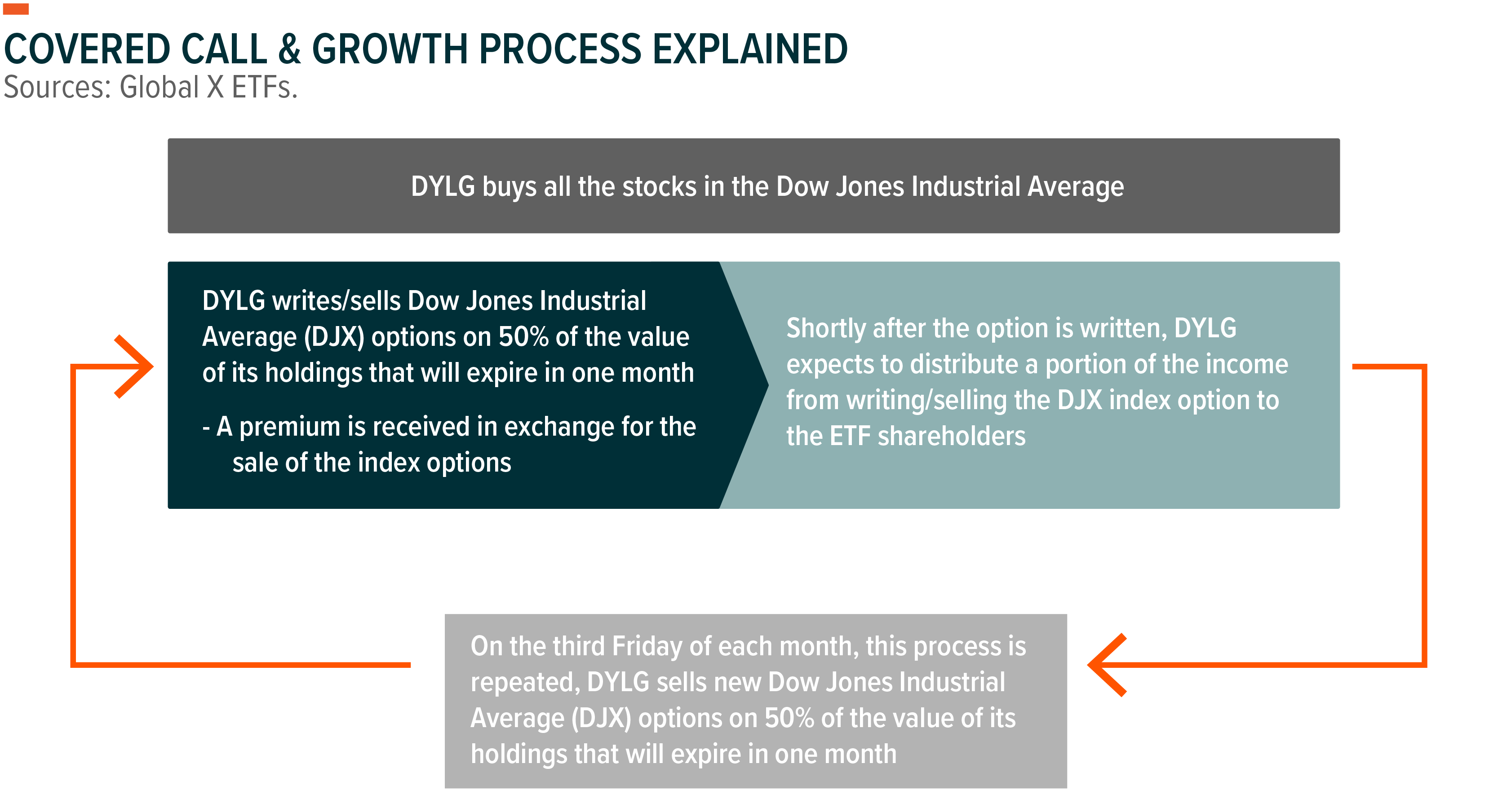
Choosing the Dow Jones Industrial Average as a Reference Asset
The Dow Jones Industrial Average is a price-weighted index, which is made up mostly of financial, healthcare, and industrial companies. Its constituency is not selected based on many formal specific quantitative rules. Selections need only be of the large-cap variety, trade on the S&P 500, and conduct business outside the realms of the transportation and utility sectors. From this pool, an index committee determines 30 highly reputable companies for inclusion that have exhibited sustained growth and dubs them “Blue Chips”. This differentiates it from the other major domestic indices like the Nasdaq 100 and S&P 500, which are market-cap weighted and tend to lean heavily toward businesses that operate in the communications and technology sectors.
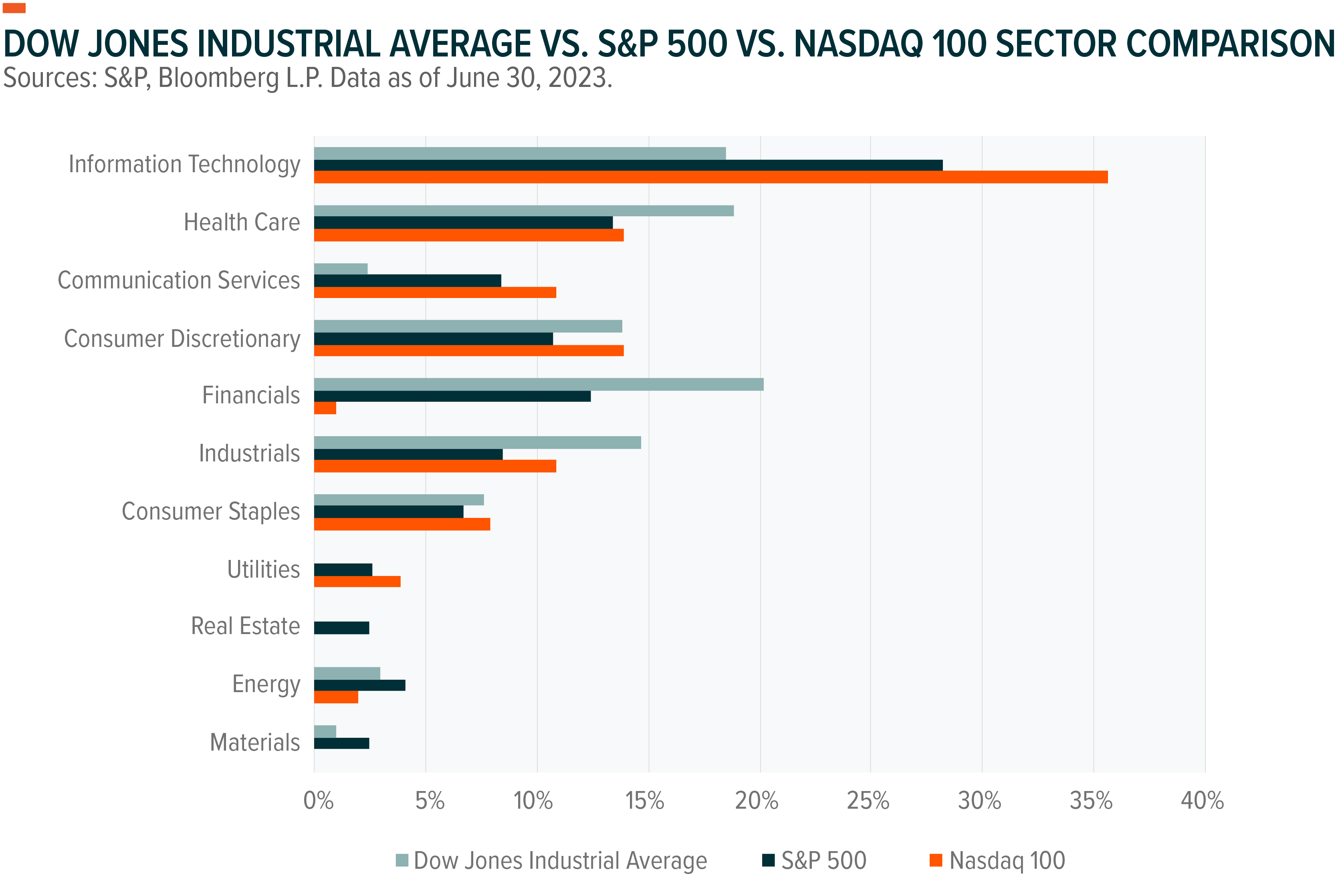
The underlying composition of these respective indices has historically dictated their performance. For instance, during times of economic prosperity, when equities are generally moving in a positive direction, the Nasdaq 100, with its growth-driven framework, has historically achieved better gains than the Dow Jones Industrial Average and the S&P 500. That said, in times when economic support is harder to find, like during the 2008 financial crisis, the Dow Jones has held ground better against drawdowns than the Nasdaq 100, and periodically proven more resilient than the S&P 500, as well.1 The price-weighted nature of the Dow Jones Industrial Average lends the index to exhibit lower levels of volatility than that of the S&P 500. Likewise, its sector exposures and makeup centered around financial and health care stocks can make it less susceptible to wide swings in price than the Nasdaq 100. The chart below highlights these characteristics. Notably, the Dow Jones Industrial Average has exhibited softer levels of implied volatility than each of the other two indexes for most of the last twenty plus years.
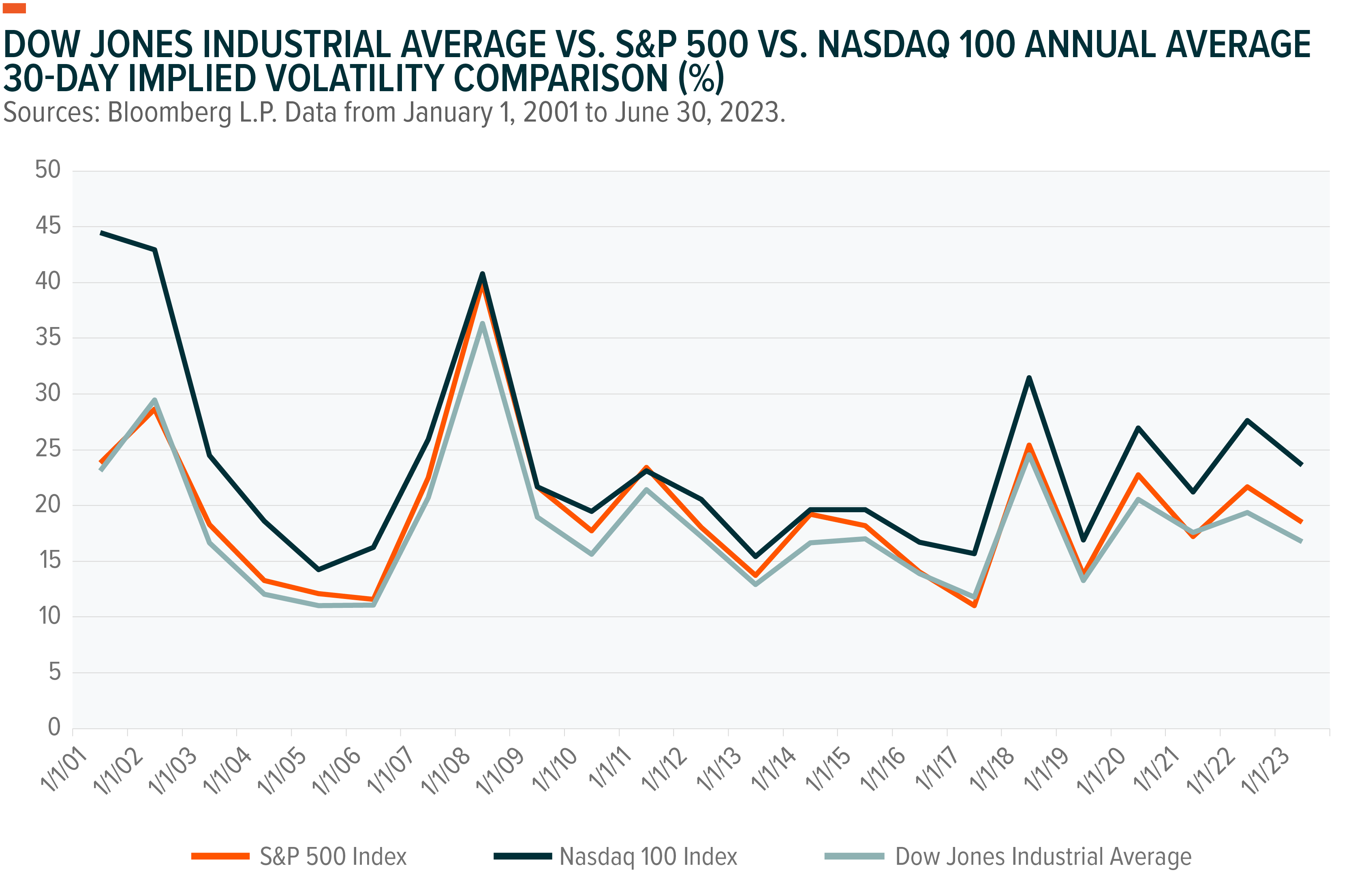
DYLG Coverage Percentage: The Tradeoff Between Growth & Income
The funds in the Global X Covered Call suite vary not only in the underlying assets that they seek to track, but also in the balance of notional value that they strive to cover. For instance, the Global X Dow 30 Covered Call ETF (DJIA) writes monthly calls against the entirety of its holdings, putting a cap on all potential price appreciation in exchange for higher levels of premium income. This is more of a conservative scenario than the one offered by the Global X Dow 30 Covered Call & Growth ETF (DYLG), which foregoes only half of the upside potential achievable by the underlying assets by writing call options against 50% of its notional balance.

The fully covered approach taken by DJIA seeks to achieve the maximum amount of current income for its investors and helps to de-lever risk from their respective portfolios. DYLG is designed to provide more of a modest degree of current income, but it’s balanced approach allows investors to maintain capital exposure to half of the upside potential of the reference asset. DYLG also provides similar sector diversification to that of DJIA, since they both harness the Dow Jones Industrial Average as their underlying index. That said, with DYLG retaining exposure to 50% of any gains of the Dow Jones Industrial Average over the life of each option, investors are still able to express a bullish attitude over a given time horizon. With the addition of DYLG, this tradeoff between growth and income is now expressible across the entirety of the Global X Covered Call suite.
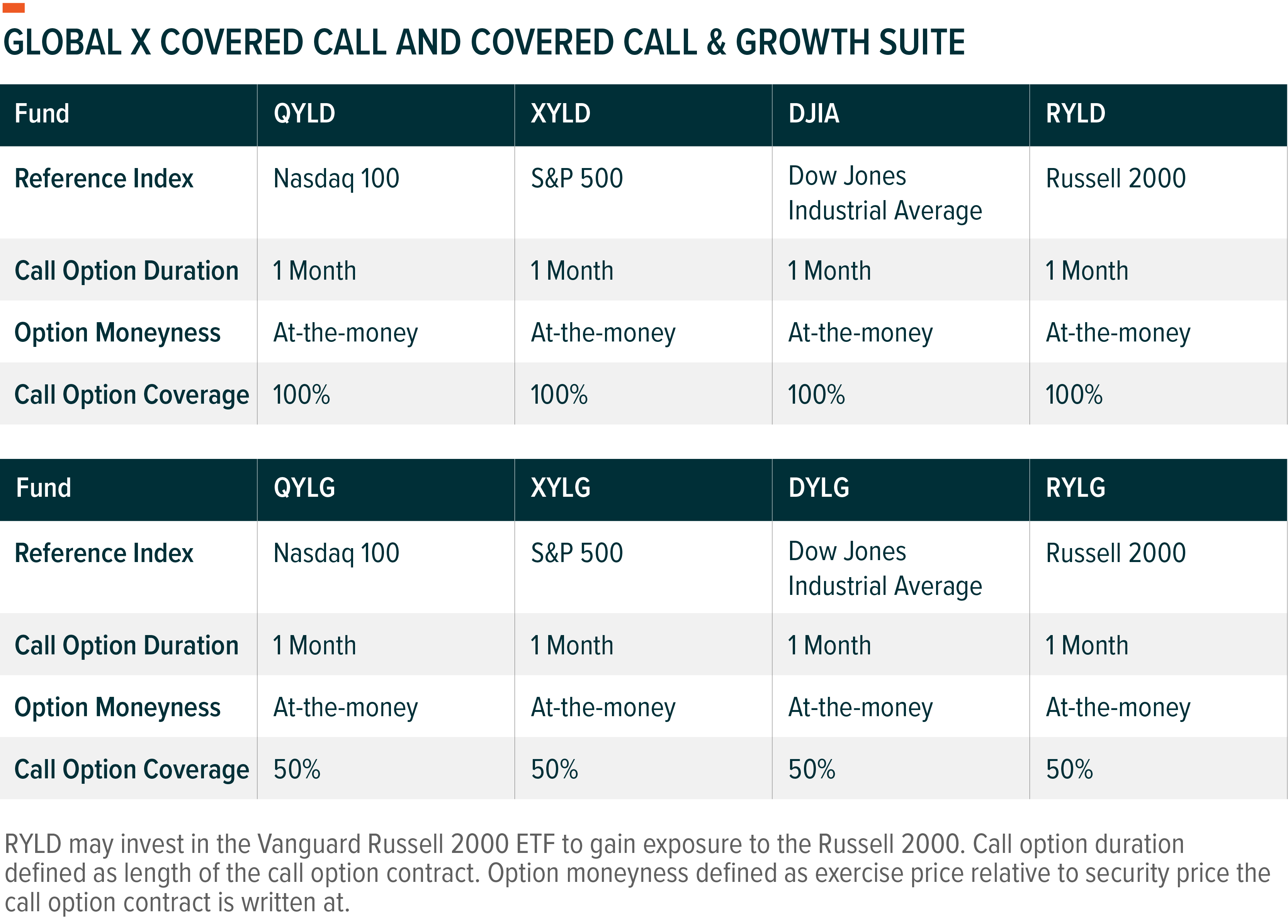
Implementing the Dow 30 Covered Call & Growth Strategy
Covered call & growth strategies can be valuable in particular trading environments. To wit, it is important to note the long-standing relationship that has been held between option premium pricing and volatility. This association may well influence the coverage decision. As market volatility rises, premiums received from writing call options typically increase as well. Meantime, the value of the underlying assets on which the options are written become more prone to wider swings in value. This supports the case for a covered call & growth strategy should investors want to participate in the growth potential of the Dow Jones Industrial Average but still like to establish a current income stream as well. The chart below highlights the option premiums and distributions that have been realized by DJIA since its inception, relative to our other fully covered funds. Although it may not prove the case every time, the premiums received from DYLG are expected to be roughly half of those attained by DJIA.
 1As a general guideline, the monthly distribution of QYLD, XYLD, RYLD, and DJIA is approximately capped at the lower of: a) half of premiums received, or b) 1% of net asset value (NAV). The excess amount of option premiums received, if applicable, is reinvested into the fund. Year-end distributions can exceed the general guideline due to capital gains that are paid out at the end of the year.
1As a general guideline, the monthly distribution of QYLD, XYLD, RYLD, and DJIA is approximately capped at the lower of: a) half of premiums received, or b) 1% of net asset value (NAV). The excess amount of option premiums received, if applicable, is reinvested into the fund. Year-end distributions can exceed the general guideline due to capital gains that are paid out at the end of the year.
Seeking to investigate the fund’s potential premiums with more granularity, the chart below harnesses a Black-Scholes options pricing model using a 50% covered call Dow Jones Industrial Average strategy.2 The relationship between the modeled premiums for the Dow Jones Industrial Average and implied levels of volatility is also notably close.
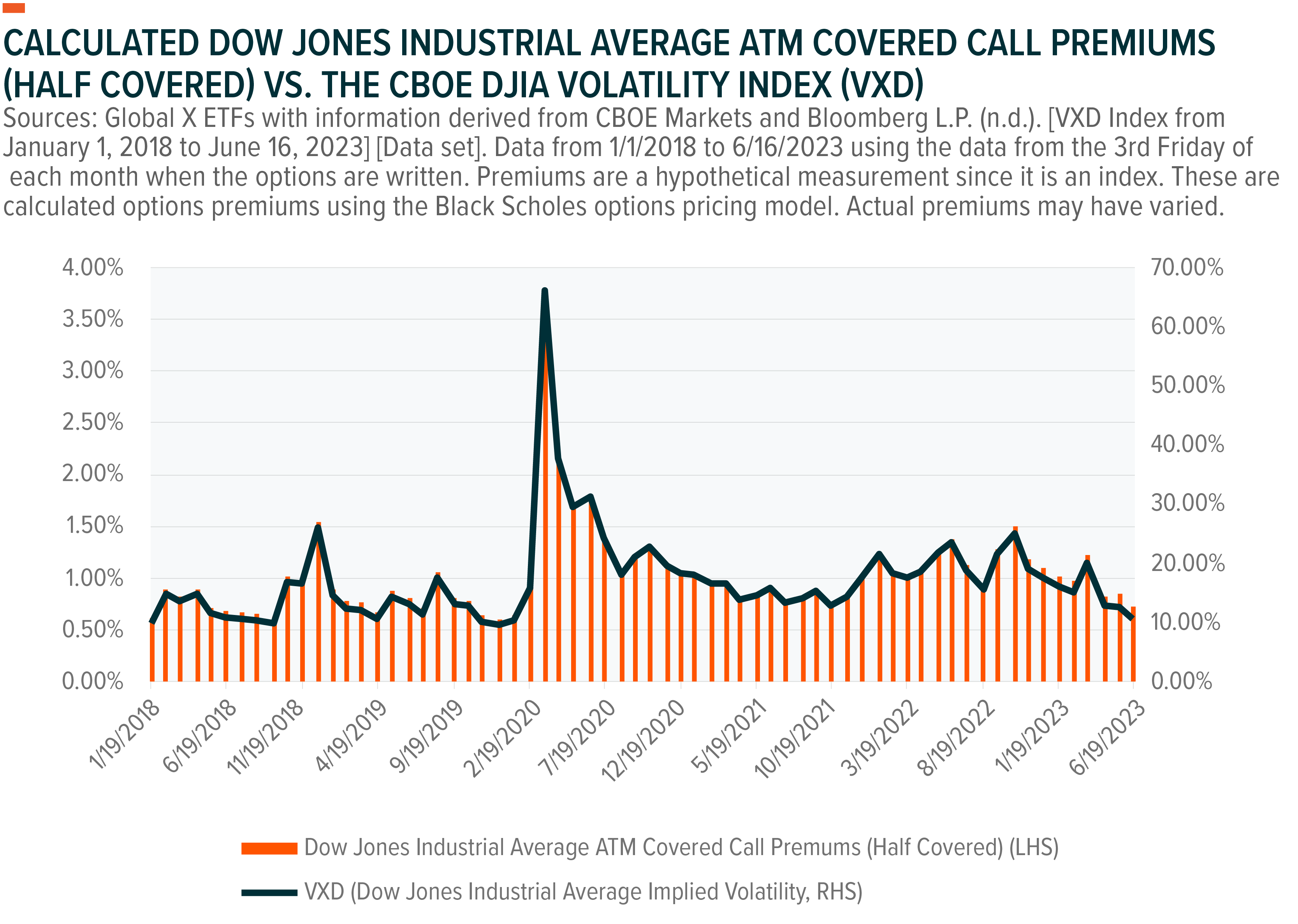
The association between premiums and volatility denotes how recent market turbulence might contribute to higher levels of income when selling covered calls. The decision to cover half or the entirety of an investment harnessing DJIA or DYLG is now possible, and depends on an investor’s goals and risk temperament.
Conclusion
We believe today’s macroeconomic environment lends itself well to a covered call and growth strategy. Markets like the Dow Jones Industrial Average are trading with elevated volatility, and this is creating an environment where wider premiums might be attained. What’s more, investors bearing concern over the potential for an economic recession, or an extended period of elevated borrowing rates, are potentially seeking more conservative positions. Investments in a fund like the Global X Dow 30 Covered Call & Growth ETF (DYLG) may represent a good solution against this backdrop, granting exposure to the underlying index, which would otherwise require a buyer to take positions in thirty different equities and investigate their own call writing strategy.
Related ETFs
Click the fund name above to view current holdings. Holdings are subject to change. Current and future holdings are subject to risk.
 Rohan Reddy
Rohan Reddy